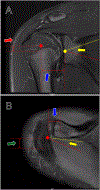Quantitative Musculoskeletal Imaging of the Pediatric Shoulder
- PMID: 38713590
- PMCID: PMC11398988
- DOI: 10.1097/PHM.0000000000002515
Quantitative Musculoskeletal Imaging of the Pediatric Shoulder
Abstract
Pediatric acquired and congenital conditions leading to shoulder pain and dysfunction are common. Objective, quantitative musculoskeletal imaging-based measures of shoulder health in children lag recent developments in adults. We review promising applications of quantitative imaging that tend to be available for common pediatric shoulder pathologies, especially brachial plexus birth palsy and recurrent shoulder instability, and imaging-related considerations of musculoskeletal growth and development of the shoulder. We highlight the status of quantitative imaging practices for the pediatric shoulder and highlight gaps where better care may be provided with advances in imaging technique and/or technology.
Copyright © 2024 Wolters Kluwer Health, Inc. All rights reserved.
Conflict of interest statement
Financial disclosure statements have been obtained, and no conflicts of interest have been reported by the authors or by any individuals in control of the content of this article.
Figures




References
-
- Arend CF, Arend AA, da Silva TR. Diagnostic value of tendon thickness and structure in the sonographic diagnosis of supraspinatus tendinopathy: room for a two-step approach. Eur J Radiol. 2014;83(6):975–979. - PubMed
-
- Bullock GS, Garrigues GE, Ledbetter L, Kennedy J. A Systematic Review of Proposed Rehabilitation Guidelines Following Anatomic and Reverse Shoulder Arthroplasty. J Orthop Sports Phys Ther. 2019;49(5):337–346. - PubMed
Publication types
MeSH terms
Grants and funding
LinkOut - more resources
Full Text Sources

